 Bangladesh has recently graduated to the rank and status of a low middle income country. Its ambition is to attain upper middle income status by 2021 and a developed country status by 2041. However, macro economy is a multi dimensional concept. While growth of GDP/ per capita income is an important indicator of a country's macroeconomic performance, there are other indicators which deserve consideration. This article deals with three dimensions of macroeconomic significance: Economic growth- usually measured by GDP growth, inflation and poverty alleviation.
Bangladesh has recently graduated to the rank and status of a low middle income country. Its ambition is to attain upper middle income status by 2021 and a developed country status by 2041. However, macro economy is a multi dimensional concept. While growth of GDP/ per capita income is an important indicator of a country's macroeconomic performance, there are other indicators which deserve consideration. This article deals with three dimensions of macroeconomic significance: Economic growth- usually measured by GDP growth, inflation and poverty alleviation.
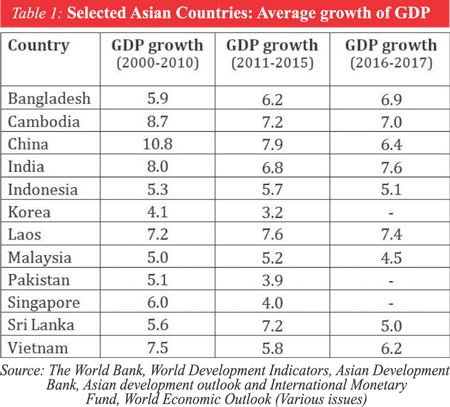 A country's performance in respect of the above mentioned indicators can be evaluated in two ways: (i) To look at change over time and (ii) How its performance compares with other countries, particularly neighboring countries.
A country's performance in respect of the above mentioned indicators can be evaluated in two ways: (i) To look at change over time and (ii) How its performance compares with other countries, particularly neighboring countries.
I have tried to make use of both the approaches.
Growth performance: There has been an acceleration of growth rate of GDP since 1980s. The rate averaged 3.8% during 1980-1985; 5.9% during 2000-2010 and 6.2% during 2011-2015 and 6.9% during 2016-2017. The country also improved its rank in growth performance among a sample of 12 Asian countries: Bangladesh, Cambodia, china, India, Indonesia, Korea, Laos, Malaysia, Pakistan, Singapore, Sri Lanka, and Vietnam.
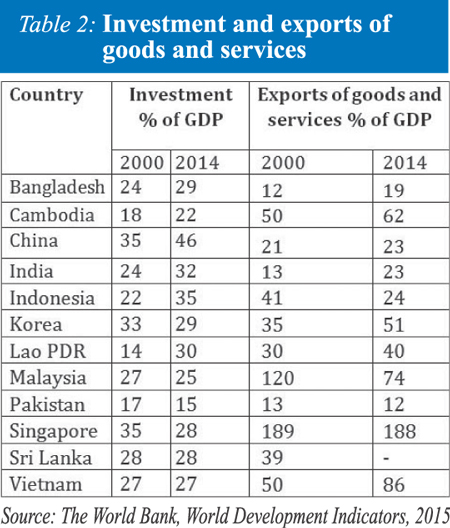 There were six countries which recorded higher growth rate than Bangladesh during 2000-2010, five countries during 2011-2015 and three countries above during 2016- 2017 (table 1).
There were six countries which recorded higher growth rate than Bangladesh during 2000-2010, five countries during 2011-2015 and three countries above during 2016- 2017 (table 1).
Indicators, Asian Development Bank, Asian development outlook and International Monetary Fund, World Economic Outlook (Various issues)
The underlying factors which contributed to accelerated growth were investment, increased labor absorption, exports and remittances. The following paragraphs briefly discuss the changes over time in these determinants as well as associated challenges to enhancement of their contributions.
Investment: As regards investment, it grew positively, albeit at a rather slow rate, rising from 24% of GDP in 2000 to 29% in 2014 (table 2).
But, the private sector investment as a proportion of GDP has remained virtually stagnant during the last one decade, around 22%. The constraints to private sector investment are well known. These include deficiencies in physical infrastructure (e.g. transportation, port facilities), inadequacy of energy supply (gas, electricity), political uncertainty, poor governance and low score in ease of doing business.
 In terms of indicators of governance the percentile rank of Bangladesh was among the lowest 30% in 2015. As regards ease of doing business the position of Bangladesh in the same year was 176 out of 189 countries indicating that there were 175 countries which performed better. There are many projects in pipeline to address infrastructure and energy problems but their implementation remains on unacceptably slow track.
In terms of indicators of governance the percentile rank of Bangladesh was among the lowest 30% in 2015. As regards ease of doing business the position of Bangladesh in the same year was 176 out of 189 countries indicating that there were 175 countries which performed better. There are many projects in pipeline to address infrastructure and energy problems but their implementation remains on unacceptably slow track.
With regard to public investment implemented mainly through the annual development program (ADP), it has shown an upward trend in recent years. However, its benefits are severely undermined by a lack of prioritisation of projects, delayed implementation, cost overrun and thinned-out resources allocated to too many projects. A recent World Bank study observed that out of 1034 projects included in FY 15 ADP, 154 projects would require 6-10 years for completion at the present levels of allocation, 106 between 11-100 years and 32 more than 100 years.
Labour: Bangladesh is currently in a situation where it can reap enormous benefits from demographic dividend with a high proportion of population in working age group. Nevertheless, there is a considerable scope for increasing utilisation of labor and thereby accelerating growth through enhanced participation of women in labor force which presently stands at 40%, lower than six Asian countries listed in table 3.
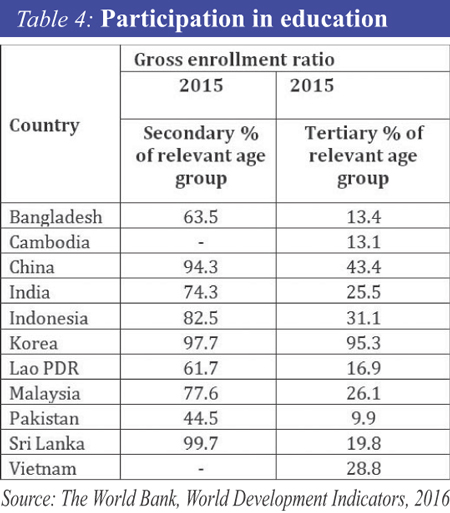 Moreover, the educational level of the work force in Bangladesh needs to be increased. Enrollment ratio at secondary level which is about 63% is lower than in many other countries and at the tertiary level it is the second lowest (table 4).
Moreover, the educational level of the work force in Bangladesh needs to be increased. Enrollment ratio at secondary level which is about 63% is lower than in many other countries and at the tertiary level it is the second lowest (table 4).
Exports: There has been a considerable improvement in export performance of Bangladesh, rising from 4.9% of GDP in 1985 to 19% in 2014 (table 2). Nonetheless, there is an urgent need for further improvement. As data in table 2 show export GDP ratio was the second lowest in Bangladesh. Policy makers in conjunction with the private sector should pay attention to upgrading the quality of existing export products, increasing the number of products in the export basket and diversifying markets.
Remittance: Here again, there has been considerable growth. It rose from 2% of GDP in FY 85 to 8.2% in FY 14. But recent decline manifested in negative growth (-2.5% in FY 16 and -14.5% in FY 17) is a matter of great concern. Among various measures needed to enhance remittance I would emphasize the need for diversification of destination markets and for sending more skilled labor to enhance per capita remittance.
Inflation: Price stability is an important macroeconomic objective for a variety of reasons. In particular, a high rate of inflation is fraught with the risk of aggravating poverty. The situation in Bangladesh in this respect is hardly commendable. In 2010, only three countries (India, Pakistan and Vietnam) had higher rates of inflation (table 5).
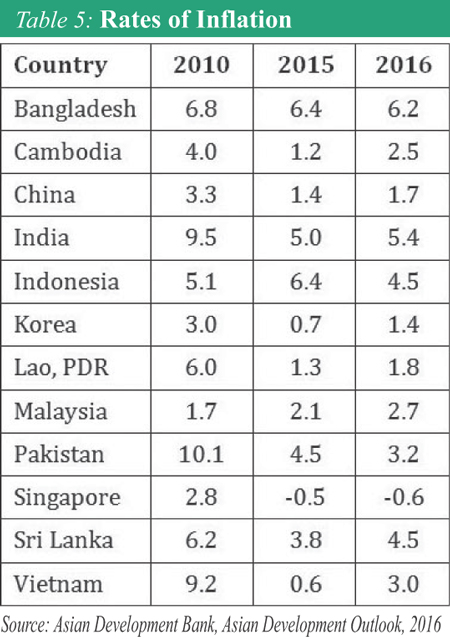
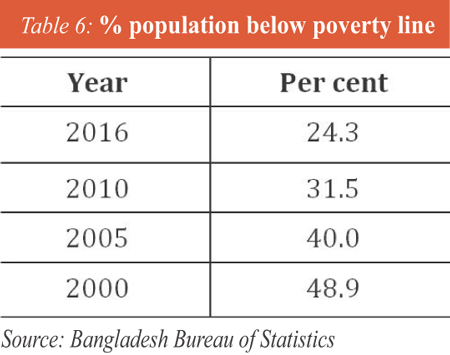 In 2016, no country had a higher rate. Policy actions are needed to increase domestic food production, to ensure that credit flow to the private sector is utilized for short gestation productive investment and to maintain stable exchange rate in order to bring down the inflation rate.
In 2016, no country had a higher rate. Policy actions are needed to increase domestic food production, to ensure that credit flow to the private sector is utilized for short gestation productive investment and to maintain stable exchange rate in order to bring down the inflation rate.
Poverty alleviation: There has been continued progress in poverty alleviation (table 6).
The acceleration of economic growth, expansion of social safety net and activities of a large number of non-governmental organizations (NGOs) have contributed to this progress. One worry is that the rate of poverty reduction has slowed down. It averaged 1.7% per year between 2005 and 2010; but declined to 1.2% per year between 2010 and 2016. This may be partly because of rising inequality of income distribution. To restore the pace of poverty reduction it is necessary to increase budgetary allocation for social safety net programmes and improve the access of poor to publicly provided health services and educational facilities. In the area of education particular attention needs to be paid to enhance enrollment of the poor to quality secondary and tertiary education. Moreover, educational system needs to be restructured with emphasis on development of technical skills so as to ensure employment in the productive sectors of the economy.
Dr. Mirza Azizul Islam is a former Adviser to the Caretaker Government, Ministries of Finance and Planning and presently a Visiting Professor at BRAC University.
© 2024 - All Rights with The Financial Express
